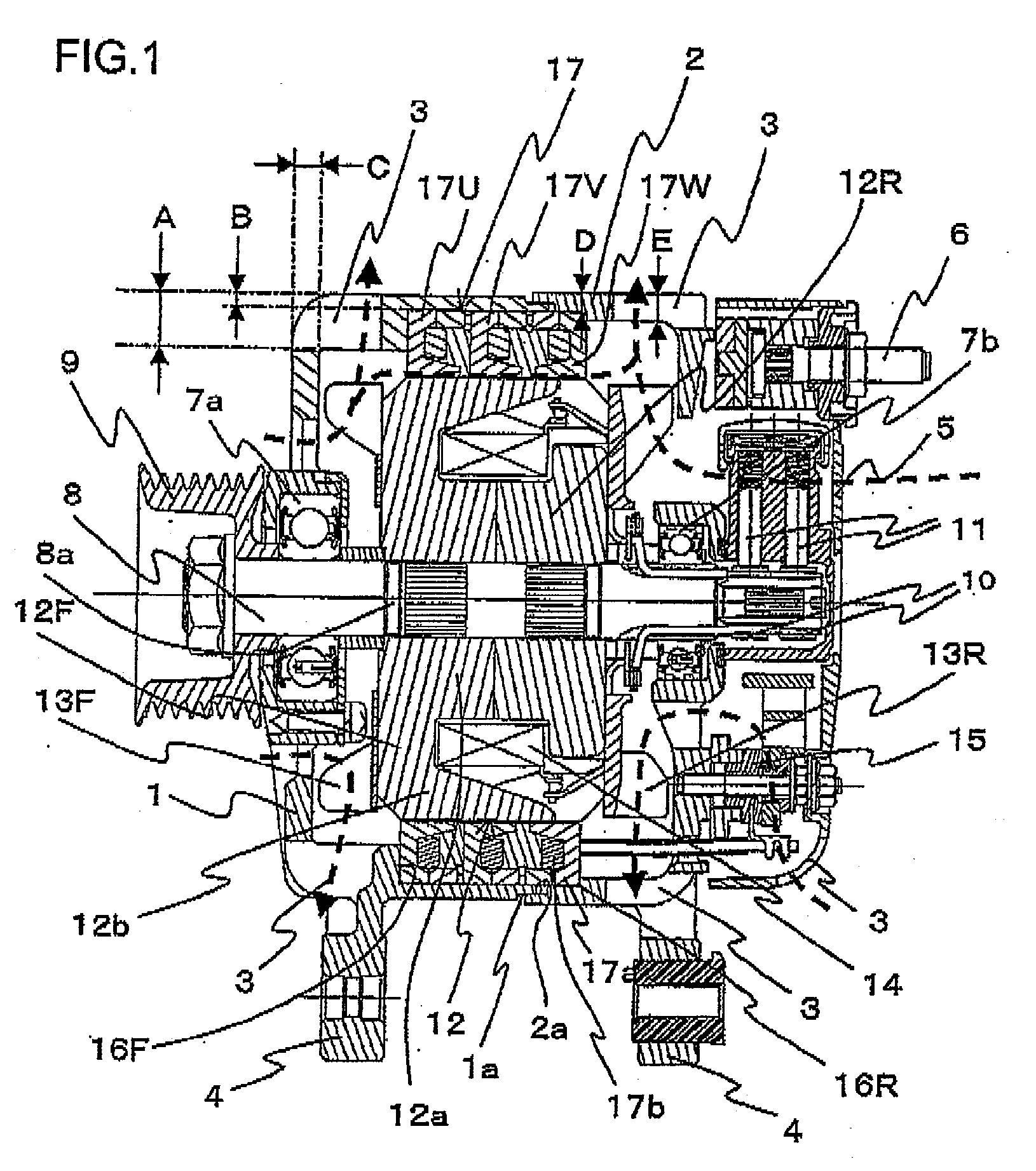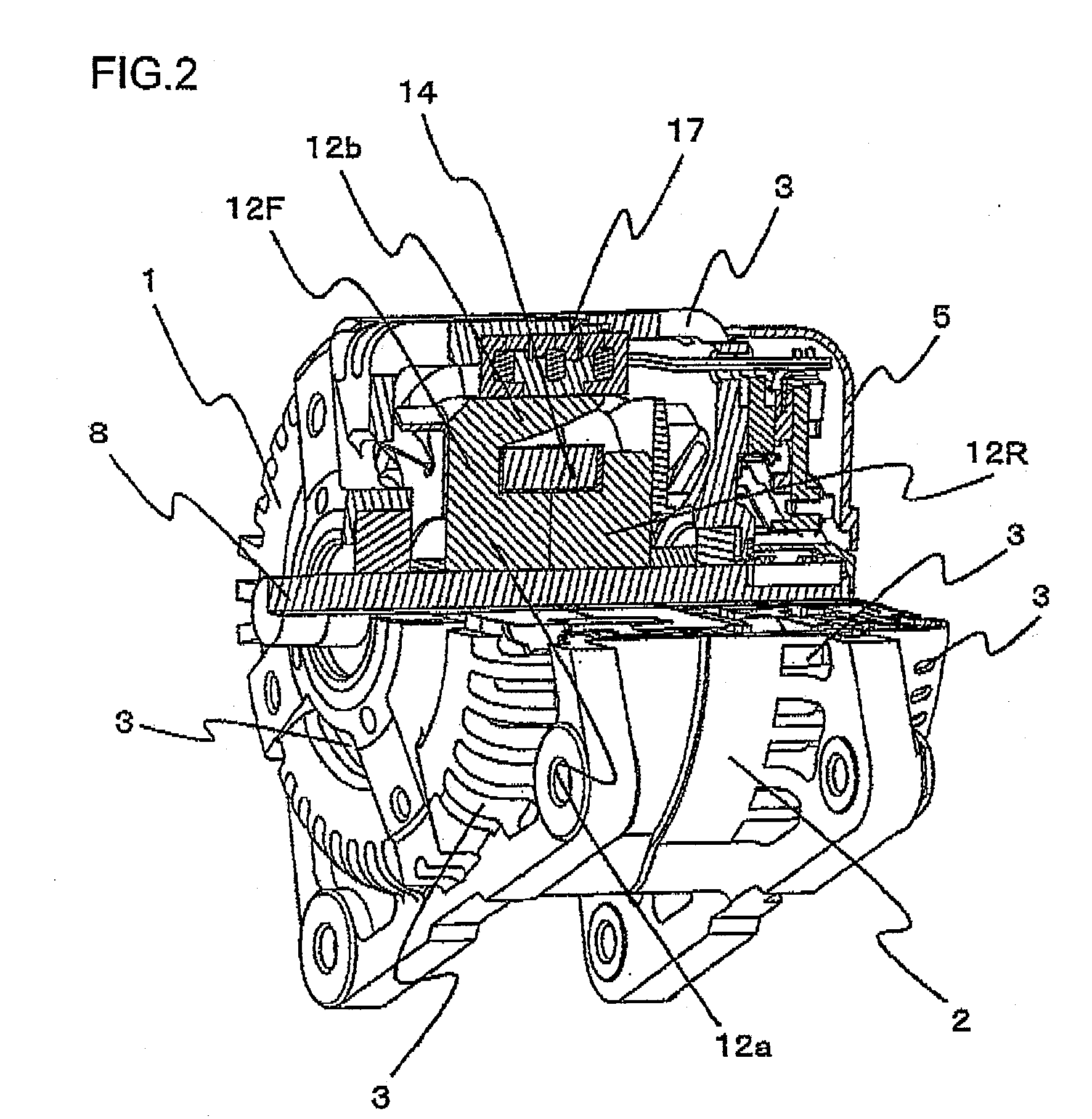Rotating Electrical Machine
- Summary
- Abstract
- Description
- Claims
- Application Information
AI Technical Summary
Benefits of technology
Problems solved by technology
Method used
Image
Examples
first embodiment
[0040]In reference to FIGS. 1 through 7, the alternator for vehicle achieved in an embodiment of the rotating electrical machine according to the present invention is described. FIG. 1 is a sectional view taken through a side of the alternator for vehicle. FIG. 2 is a perspective showing the alternator for vehicle in a partial sectional view. FIG. 3 is a perspective of a rotor and a stator in a partial sectional view. FIG. 4 is a perspective of the rotor. FIG. 5A is a perspective showing the stator alone in a partial sectional view. FIG. 5B shows the stator viewed from the inner circumferential side. FIG. 6 is a perspective showing the phase stators. FIG. 7A is a perspective of a phase stator corresponding to a single phase and FIG. 7B is a perspective showing various parts in FIG. 7A.
[0041]The alternator for vehicle achieved in the embodiment in FIG. 1 includes a front bracket 1 disposed on the left side in the figure and a rear bracket 2 disposed on the right side in the figure. T...
second embodiment
[0098]As illustrated in FIG. 7, the stator core component members 174 and 175 assume a substantially unvarying thickness over their outer circumferential surfaces except for where the projecting portions 1744 and 1754 and the recessed portions 1745 and 1755, at which the stator core component members are to be fitted together, are present. The following is a description of the flow of magnetic flux generated at the rotor 12 in the rotating electrical machine assuming this structure.
[0099]FIG. 8 shows the stator core component member 175, one of its stator core magnetic poles 1752, the stator core component member 174, one of its stator core magnetic poles 1742 and part of the stator coil 173.
[0100]In the first embodiment, magnetic fluxes alternately assuming N polarity and S polarity are generated at the rotor claw poles 12b extending from the front-side rotor member 12F and the rear-side rotor member 12R and these magnetic fluxes interlink with the stator claw poles 1742 and 1752. ...
third embodiment
[0121]FIG. 13 shows a stator claw pole 1752 achieved in the third embodiment of the present invention in a sectional view similar to that presented in FIG. 11B taken through the central area A-A along the axial direction.
[0122]Magnetic theory indicates that the quantity of the air-gap flux ØL corresponding to the reactance described in reference to the second embodiment is in proportion to the gap distance Lg and also in reverse proportion to the sectional area Sg of the magnetic core facing the gap.
[0123]Accordingly, the thickness of the stator claw pole 1752 in FIG. 13 at the surface facing opposite the stator coil 173 is adjusted over two stages, Lc1 and Lc2, with the smaller thickness Lc2 assumed at the front end portion 1752a of the claw pole. As a result, the stator claw pole 1752 is formed with the front end portion 1752a thereof assuming a smaller sectional area Sg2 than the sectional area Sg1 assumed on the base side of the stator claw pole 1752. It is to be noted that sinc...
PUM
 Login to View More
Login to View More Abstract
Description
Claims
Application Information
 Login to View More
Login to View More - R&D
- Intellectual Property
- Life Sciences
- Materials
- Tech Scout
- Unparalleled Data Quality
- Higher Quality Content
- 60% Fewer Hallucinations
Browse by: Latest US Patents, China's latest patents, Technical Efficacy Thesaurus, Application Domain, Technology Topic, Popular Technical Reports.
© 2025 PatSnap. All rights reserved.Legal|Privacy policy|Modern Slavery Act Transparency Statement|Sitemap|About US| Contact US: help@patsnap.com



